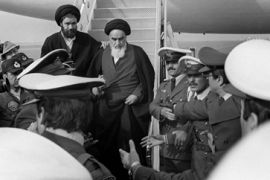Iran remembers Khomeini’s return
Political divisions evident on anniversary of homecoming leading to Islamic revolution.

|
People gathered for a ceremony at the |
Iran has marked the anniversary of the return of Ayatollah Ruhollah Khomeini to the country 31 years ago – a homecoming which triggered the 1979 Islamic revolution.
Bells rang out from schools, trains and boats at 9.33am, the moment Khomeini’s aircraft touched down on February 1, 1979, on his return from exile in Paris, France.
Mahmoud Ahmadinejad, the Iranian president, and other senior Iranian officials paid homage to Khomeini at his mausoleum in southern Tehran on Monday.
“I am sure the Iranian people will do something on February 11, which will disappoint the enemies and the tyrants completely,” he said in a short address at Khomeini’s mausoleum on Monday.
“This year will see the definite failure of capitalism, inhumane liberalism and the start of globalisation of the Islamic revolution.”
The tributes marked the start of 10 days of celebrations, which culminate on February 11, which is the 31st anniversary of the fall of the shah, who ruled the country for nearly four decades.
Protesters warned
Iranian authorities have given warning that they will crack down on protesters if they attempt to stage another anti-government demonstration on February 11, when traditionally hundreds of thousands of Iranians take to the streets in celebration.
Mir Hossein Mousavi and Mehdi Karroubi, the reformist candidates defeated in the June presidential election, have implicitly called on their supporters to demonstrate on the occasion, Karroubi’s website Sahamnews.org said on Saturday.
On his arrival on board an Air France jet 31 years ago, Khomeini, then 76, vowed to establish a new government in Iran.
“I will appoint a government. I will slap this government on the mouth,” he said in an address at Tehran’s Behesht Zahra cemetery, referring to the government of the shah’s last prime minister Shahpour Bakhtiar, who fled Iran before Khomeini’s arrival.
Cult of personality
Khomeini assumed the role of Iran’s supreme leader, which he held until his death in 1989.
During his conservative rule, Iran became embroiled in a debilitating conflict with neighbouring Iraq, then under Saddam Hussein’s rule. Over a million people were killed on both sides during the eight-year war.
| Watch Al Jazeera’s report on how Iranians born in 1979 feel about their country |
Khomeini also backed students who stormed the US embassy in Tehran in November 1979 and took its personnel hostage for 444 days, prompting Washington to sever ties with the Islamic republic.
Khomeini branded the US as the “Great Satan” and diplomatic ties were severed.
Relations between Iran and the US have deteriorated further during Ahmadinejad’s rule, who was controversially elected for a second term last June in an election the opposition claims was massively rigged.
Tension has also peaked between Iran and the West over Tehran’s nuclear programme, which world powers believe is masking an atomic weapons programme despite repeated assertions to the contrary by Iranian leaders.
Ahmadinejad’s June 12 re-election triggered one of the worst political crises in the history of the Islamic republic.
Political crisis
Some of the early pillars of the government, such as Mousavi, who was prime minister under Khomeini, and Karroubi, have turned into its bitter opponents, criticising the authorities for “fraudulently” re-electing Ahmadinejad.
Their opposition, backed by powerful figures such as ex-presidents Akbar Hashemi Rafsanjani and Mohammad Khatami, has shaken the pillars of the government and bitterly divided the theocracy.
Violent clashes since the June election between opposition supporters and security forces have killed dozens, wounded hundreds and seen thousands of arrests.
Hundreds of protesters have been put on trial on charges of threatening national security and attempting to topple the regime.
The latest deadly clash took place on December 27 during the Shia commemoration of Ashoura.